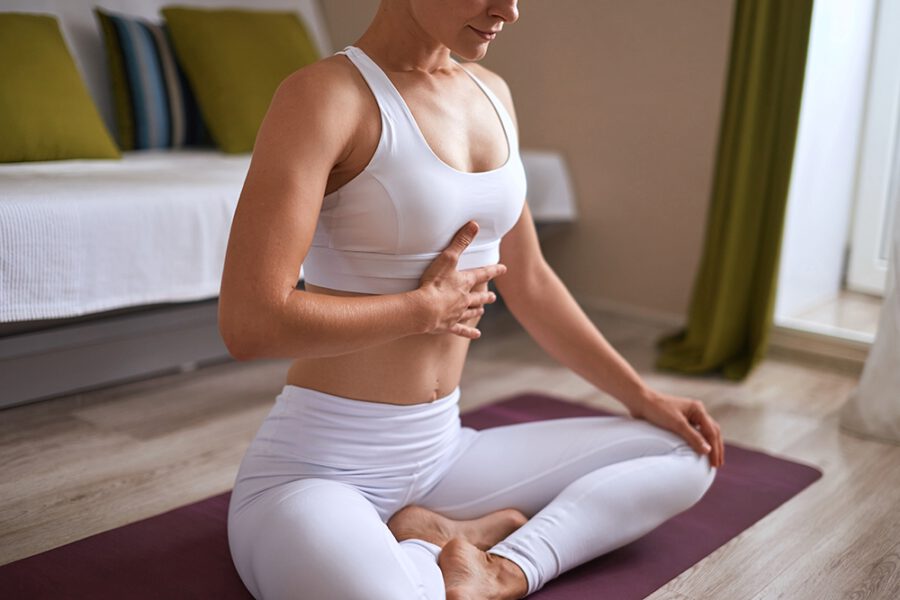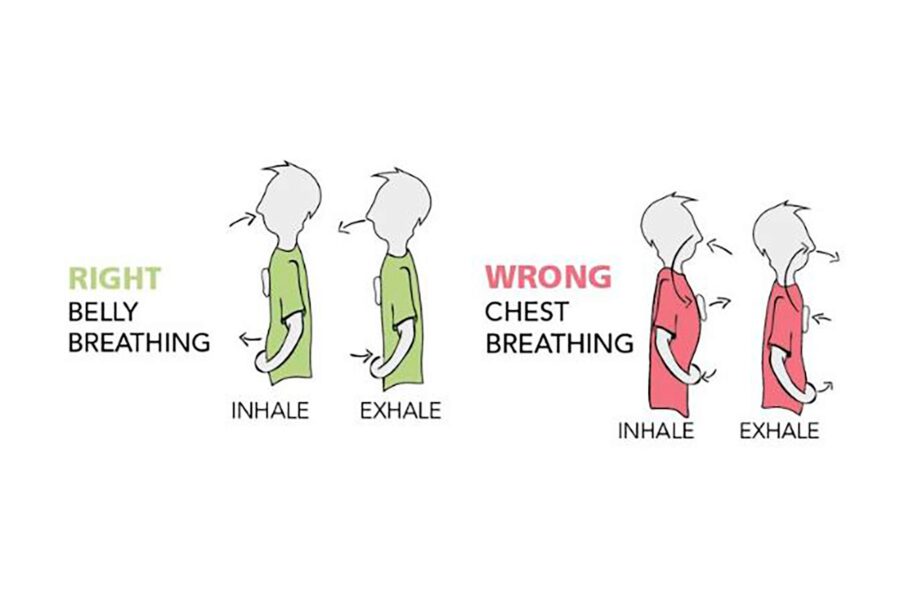How Breathing Techniques can Improve Your Health and Fitness
We take breathing for granted.
However, effective breathing has many physical and psychological benefits.
Whether you practice strength training, running or yoga, we will teach you various breathing techniques to help you remain calm and perform at your best.
The purpose of breathing is to deliver oxygen to the cells and to remove excess carbon dioxide.
Before we can get into how to breathe when working out, we first need to differentiate the two types of breathing:
- Chest breathing: also known as shallow breathing. It's identified by an expansion and contraction of the chest, mainly used during intense exercising or stressful situations (fight or flight response). Our body can get tense by using this type of breathing. However, we tend to use chest breathing in our day to day lives, which can make us more anxious that we need to be.
- Diaphragmatic (abdominal or belly) breathing: also known as deep breathing. It is characterized by intentional breathing into the belly without moving the chest. It's very beneficial, because it brings more oxygen to your lungs than chest breathing, which makes a good balance between incoming oxygen and outgoing carbon dioxide. This type of breathing is used in Yoga and other disciplines, it has many physical and psychological benefits.
- Improves blood oxygenation
- Decreases blood pressure
- Reduce stress and calms you down
- It relaxes your abdominal organs, which improves digestion
- Relieves neck and shoulder tension, which promotes good posture
- Improves focus
Can you use both chest and diaphragmatic breathing? Yes. When you're exercising, you will naturally use chest breathing, since the body is under stress. Nevertheless, it's highly recommended to practice diaphragmatic breathing during your rest periods or light movements such as: walking, yoga...
We will focus on proper breathing and bracing for different types of workouts at the end of this article.
Diaphragmatic breathing is beneficial for everyone, but it will require practice.
Here's a diaphragmatic breathing workout:
- Lie or sit down
- Close your eyes
- Put one hand your upper chest
- Put one hand your abdomen (belly)
- Now breathe in for 4 seconds using your nose and abdomen
- Then breathe out for 4 seconds using your nose and abdomen
- You should feel no movement in the chest
- Keep your attention on your breath
- Repeat this 10 times
The nose is made for breathing and the mouth for eating. End of the article. Just kidding, but not really.
Nose and mouth breathing both allow you to bring oxygen into the lungs. A high percentage of the population breathes through their mouths (including my old self). However, mouth breathing impacts oxygen/carbon dioxide exchange. This leads to breathing faster than usual, which can create hyperventilation, bad oral health, high blood pressure, fatigue, sleep apnea, allergies...
Whereas the nose is the designated organ for breathing. When you breathe through your nose, Nitric oxide (NO) gets released (which mouth breathing does not). Nitric oxide is a vasodilator, meaning it dilates blood vessels, which increases blood supply and lowers blood pressure. Nitric oxide improves oxygen exchange and increases blood oxygen by 18 percent.
Breathing through your nose when exercising will feel strange at first, but you will find it very powerful once you master it.
Personally, I highly recommend you to slowly introduce nose breathing when you're exercising at low/moderate intensity.
- Warms and humidifies air
- Releases nitric oxide, which improves oxygen uptake
- Naturally activates diaphragmatic breathing
- Reduces fatigue
- Decreases risk of apnea
When you're lifting weights or doing any bodyweight movement, it is important to find the right breathing rhythm to help you perform at your best and have the right posture.
Breathing for strength training should should go as follows:
- Breathe in (diaphragmatic breathing): when you're at rest or on the negative (muscle lengthening / recovery) part of the movement. For example, lowering the weight in a bench press, squat, curl... Or when you're on your way down of doing a push up, pull up, dip...
- Brace: by engaging your core, which will create intra-abdominal pressure and stabilize the spine before performing a movement. This will allow you to feel more stable and will make you stronger.
- Breathe out: when performing the positive (muscle contracting / exertion) part of the exercise. For example, pressing the weight in a bench press, squat, overhead press. It's important to keep your core engaged while breathing out, which will keep you posture in check.
You should try nose breathing if you're performing workouts that doesn't bring your heart rate too high.
Most runners tend to follow a 2:2 breathing rhythm, which means breathing in, using your diaphragm, when taking two steps (left, right) then breathing out on the two following steps.
This will synchronize your breath with your cadence and will help you perform well.
Nose breathing can be difficult to practice while running if you're new to it, but it's very effective.
Here's some breathing examples using heart rate training zones:
- Zone 1, 50-60% Maximal Heart Rate (walking): Nasal in / Nasal out
- Zone 2, 60-70% Maximal Heart Rate (fast walking): Nasal in / Nasal out
- Zone 3, 70-80% Maximal Heart Rate (running): Power nasal in / Power nasal out
- Zone 4, 80-90% Maximal Heart Rate (football): Power nasal in / Mouth out
- Zone 5, 90-100% Maximal Heart Rate (sprinting): Power nasal & Mouth in / Mouth out
Sama vritti (equal breathing) is a straightforward breathing techniques using equal duration time between inhales and exhales.
An equal breathing workout would look like this:
- Breathe in (diaphragmatic & nose breathing): 4 seconds (or 6, 8, 10 seconds)
- Breathe out (diaphragmatic & nose breathing): 4 seconds (or 6, 8, 10 seconds)
- Repeat 10 times
- Then let the breathe return to normal
This will calm your mind and body, it's is a great technique to use right before bed.
Or you could do a power breathing technique that will help you feel energized to start the day: An equal breathing workout would look like this:
- Breathe in (diaphragmatic, nose & mouth breathing): 2 seconds
- Breathe out (diaphragmatic, nose & mouth breathing): 2 seconds
- 30 rounds
- 1m breath hold
- Repeat this 1-3 times
- Then let the breathe return to normal
- Chest breathing creates a "fight or flight" response, which increases stress
- Diaphragmatic (abdominal/belly) improves blood oxygenation and helps you stay calm
- A high percentage of the population uses mouth breathing, but it can cause issues in the long run
- Nose breathing releases nitric oxide, which improves oxygen uptake, reduce fatigue and much more
- Try using diaphragmatic and nose breathing as much as you can, it will help you perform better and help manage stress in your day to day life

